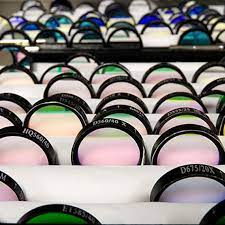Optical filters are components that selectively transmit or block certain wavelengths of light while allowing other wavelengths to pass through. They are commonly used in a wide range of applications such as photography, spectroscopy, fluorescence microscopy, astronomy, and telecommunications. Optical filters can be divided into two main categories: absorptive filters and interference filters. Absorptive filters use dyes or colored glass to selectively absorb certain wavelengths of light, while allowing other wavelengths to pass through. Interference filters work by exploiting the interference of light waves to selectively transmit or reflect certain wavelengths. There are many different types of optical filters, including: Bandpass filters: These allow light within a certain wavelength range to pass through while blocking light outside that range. Longpass filters: These allow longer wavelengths of light to pass through while blocking shorter wavelengths. Shortpass filters: These allow shorter wavelengths of light to pass through while blocking longer wavelengths. Neutral density filters: These attenuate light evenly across the entire visible spectrum and are used to reduce the overall intensity of light. Polarizing filters: These transmit light waves that vibrate in a certain direction while blocking those that vibrate in other directions. Dichroic filters: These separate different colors of light by selectively reflecting or transmitting certain wavelengths. Optical filters can be made from a variety of materials, including glass, plastics, and films. The selection of a filter depends on the specific application and the desired wavelength range to be transmitted or blocked.
Phone
+91-9310249352 / +91-8605504814
+91-9310249352 / +91-8605504814
Optical Filters

